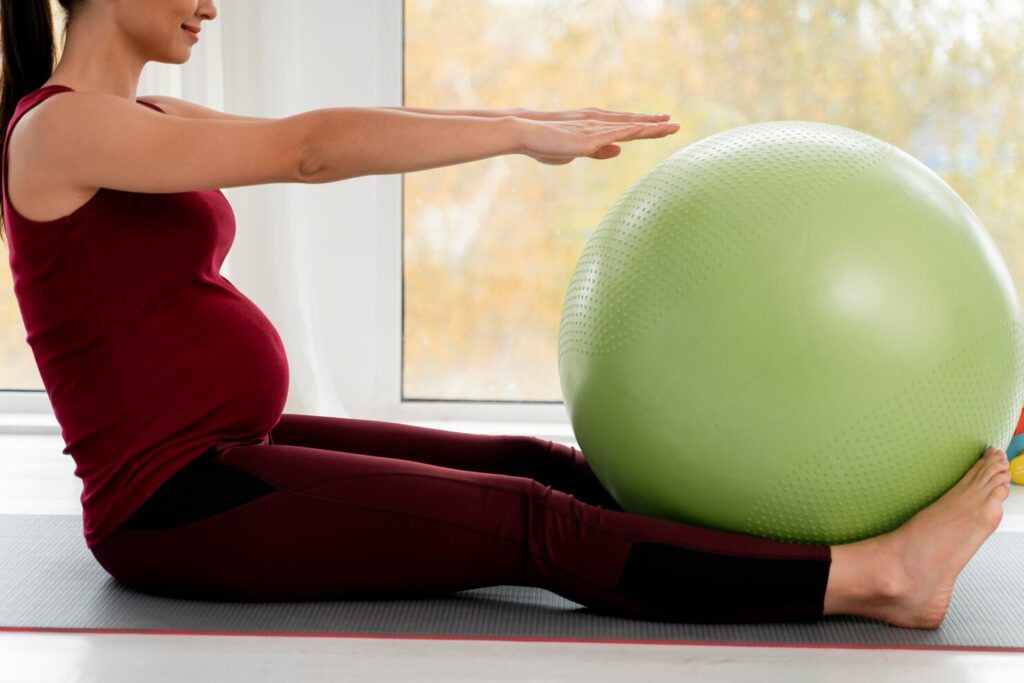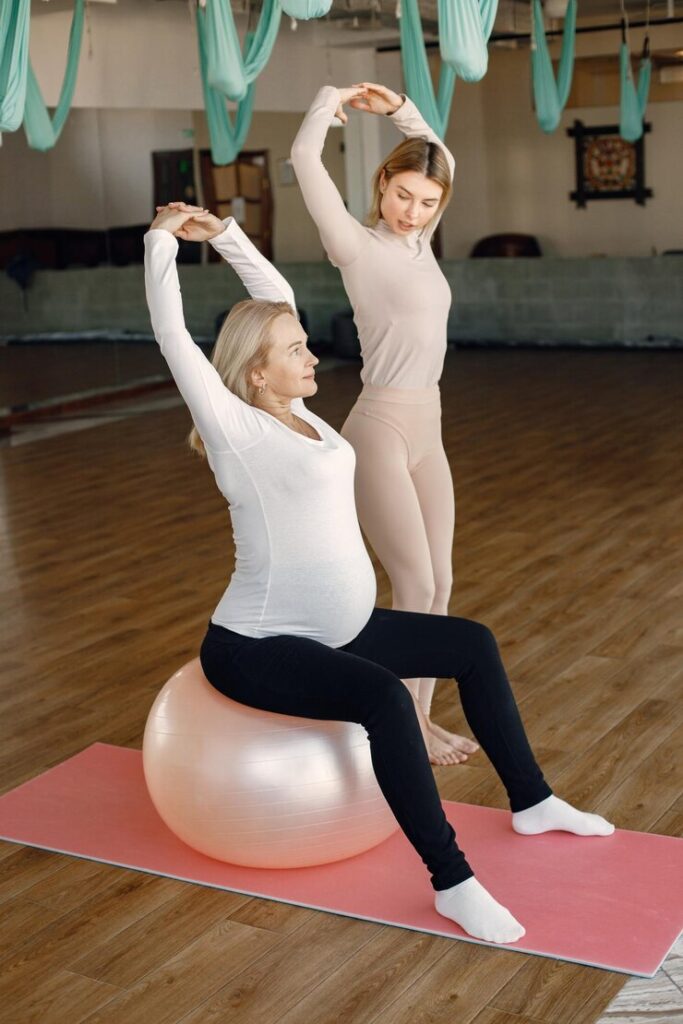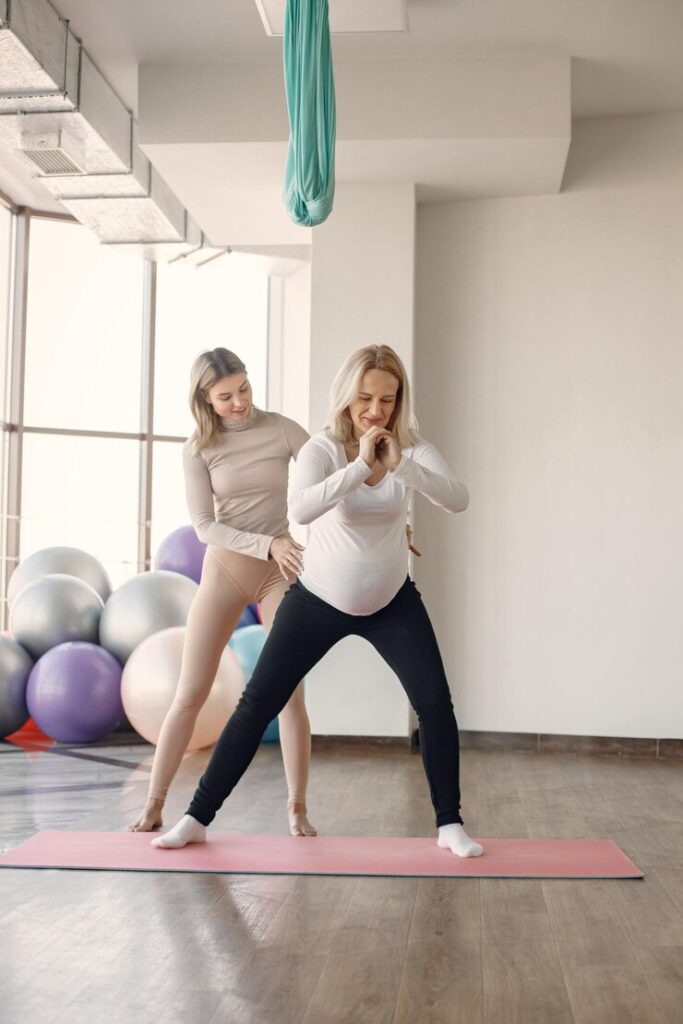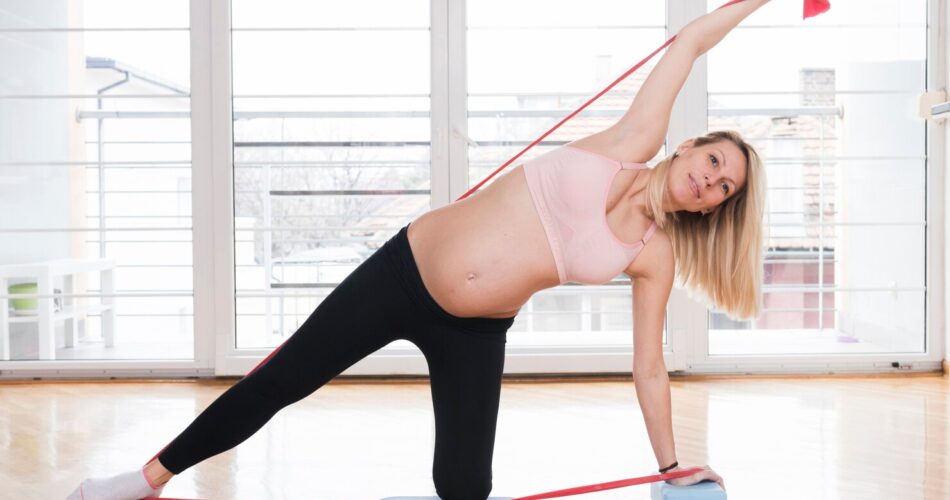Pilates during pregnancy is the best choice for women who decide to maintain their physical activity while expecting a baby. The basic exercises of this type of Pilates aim to strengthen the pelvic floor, abdominal, and back muscles, which is critically important for future moms. These muscles are responsible for body balance, good posture, and strength. Such exercises help develop the muscles that support the back and pelvis as the load increases.
During pregnancy, they deform as the growing baby increases the tension of the pelvic floor and abdominal muscles. Besides, the hormone relaxin acts as a ‘softener’ of the tough ligaments that connect bones throughout the body. During this period, damage is inevitable if the ligaments, which are stretched more than usual, are overloaded. Pilates for pregnant women can help minimize the risks of negative consequences of these processes.

Can pregnant women do Pilates?
During pregnancy, women can practice Pilates whether they have previously trained in this system or not, as long as the gynecologist does not see any contraindications. It is important to understand that expectant mothers should not engage in general group classes. They need to attend specialized Pilates classes for pregnant women, as not all exercises can be performed during pregnancy.
It is better to train with a professional trainer in a gym with an individually tailored program that takes into account the pregnant woman’s well-being, her level of physical fitness, and the stage of pregnancy. With the correct program design, Pilates for pregnant women is not only absolutely safe but also beneficial. Nonetheless, it’s important to ensure that during the workout, the woman drinks enough water and takes breaks to rest.

Benefits of Pilates for Pregnant Women
The main goal of Pilates is to strengthen important muscles that will help a pregnant woman avoid issues with bodily functions that arise during pregnancy and after childbirth. The benefit of doing Pilates during pregnancy lies in the ability to strengthen the back, abdominal, and pelvic floor muscles through low-impact exercises. At this stage, it helps reduce the risk of the most common discomforts.
Additional benefits of this program include:
- improved circulation – helps to avoid fluid retention in the legs and feet, which is common during this period;
- toning of the pelvic floor and abdominal muscles – exercises help maintain good well-being post-delivery, especially when Pilates is combined with Kegel exercises;
- gaining the skill of breath control – important for the developing fetus, helps in the birthing process.
Dangerous and Safe Movements
Pilates during pregnancy has certain trimester-specific restrictions.
Thus, during early pregnancy, rolling on the back is appropriate to relieve tension in the lower back muscles. After the first trimester, experts do not recommend exercises lying on the back due to the pressure on the abdomen, as this can lead to dizziness due to high pressure on the vena cava.
In the second trimester, there are practically no restrictions besides this, as this period is considered the most favorable for gestation.
In the third trimester, expectant mothers should use a pillow, placing it under the hips or buttocks when performing exercises. Throughout the entire pregnancy, exercises should be avoided:
- with excessive stretching due to the risk of injury;
- performed on the stomach;
- requiring abdominal muscle tension;
- involving breath holding.
How to Exercise When Pregnant
When deciding to do pilates for pregnant women, it is important to attend workouts regularly – 2-3 times a week, to prevent stress on the body caused by exercising after a long break. However, the recommendation for the frequency of workouts mostly concerns beginners. Those who attended classes before pregnancy can exercise more often. The average duration of a workout is approximately half an hour. It begins with a warm-up with breathing exercises.
The main part includes exercises selected and arranged in order by the trainer, taking into account all individual characteristics. The trainer also helps to perform them correctly. The final part is aimed at relaxation and also includes breathing exercises, similar to yoga. The technique of performing exercises is important, especially breathing. The musical accompaniment is slow and relaxing, movements are smooth, focusing on muscle work and stretching.

What Pregnant Women Should Consider When Doing Pilates
When doing Pilates exercises during pregnancy, a woman should constantly monitor her own well-being. It is important to observe, even in a favorable second trimester, whether breathing becomes more frequent, if there is dizziness, or a feeling of weakness. It’s best to start exercising no earlier than an hour after eating. Exercises in the lying on the back position are completely excluded from the training program, even in the first trimester. To avoid the risk of hypothermia and subsequent colds, Pilates classes, like yoga, are recommended to be conducted on a mat or gym mat.
One should exercise caution with balance exercises and when pushing the range of any movement to its limit. Do not overexert, even if feeling well, as it may do more harm than good. The best position for exercising in all trimesters is on your knees, with hands resting on the floor.
Precautions
Pilates during pregnancy is not without certain risks, even though it is one of the most recommended types of physical activity for women expecting a baby. Therefore, a pregnant woman needs to visit a doctor in advance, and exercises should only be performed under the guidance of a professional. Certain movements are prohibited both in the early stages and in the 3rd trimester; only those allowed by a specialist can be done.
In certain cases, pilates for pregnant women is not recommended. These include:
- existing risk of miscarriage;
- risk of placental previa development;
- severe course of toxicosis;
- history of miscarriages and preterm births;
- occasional bleeding episodes;
- diagnosis of “polyhydramnios”;
- presence of high blood pressure;
- diagnosed cardiovascular system disorders;
- cramping pain after exercising.
Pilates Exercises for Pregnant Women: 1st Trimester
Exercises in the 1st trimester should be conducted under the supervision of an instructor to ensure that incorrectly chosen load does not provoke a miscarriage. Pilates exercises for pregnant women can include the following:
- Standing with legs slightly apart, arms along the body, take a deep breath with the chest until the ribs “expand”. Then rhythmically breathe with the abdomen, extending the spine upwards.
- In a standing position, tilt the head left-right, back-forward, perform rotational movements from right to left and back, ensuring the head is not thrown back.
- Straighten the arms out to the sides, take a deep breath, “stretching” the body. Exhale, lowering the arms.
- While on all fours, simultaneously lift the right arm and left leg in gentle movements, then the left arm and right leg.
- In the same pose, perform “cat” bends.
- Sit in the lotus pose or any other comfortable position, straighten your back, and turn left and right.
Features of Pilates in the 2nd-3rd trimester
The most comfortable period for doing Pilates during pregnancy is the 2nd trimester. At this stage, exercises from the 1st trimester are performed with the addition of special movements that help the fetus take the correct position in the uterus – head-down position. For example, standing on all fours with support on your knees and elbow joints, breathe deeply and evenly, and hold this position for 10-15 minutes.
You can roll the ball with your buttocks from side to side while sitting on a fitball with your legs widely spread for 10-15 minutes. A 10-minute exercise on the ball with tension helps strengthen the pelvic floor.
from the perineum to the highest point with slow relaxation. If any discomfort occurs, it is necessary to stop the exercises immediately and see a doctor. The workload is reduced in the 3rd trimester. Pilates classes for pregnant women are conducted in the complete absence of contraindications.


Download the app and get 7 days free use
 eng
eng rus
rus deu
deu spa
spa fra
fra ita
ita por
por srp
srp tur
tur ukr
ukr por
por bos
bos



